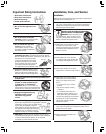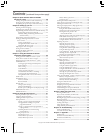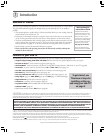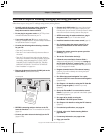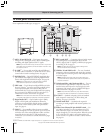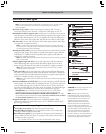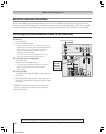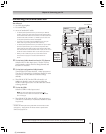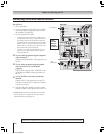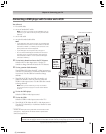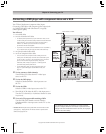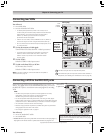
(E) 51/57/65H93
Copyright © 2003 TOSHIBA CORPORATION. All rights reserved.
11
Overview of cable types
Component video cables (red/green/blue)
Coaxial (F-type) cable
Standard A/V cables (red/white/yellow)
S-video cable
CAUTION: Do not plug in any power cords
until you have finished connecting all
equipment.
DVI-D digital single-link cable
Dual-wand IR blaster/G-LINK cable
(2 included)
Note: Two dual-wand IR blaster/G-LINK cables are included with your TV. All other required
cables, if not provided with your other devices, can be purchased at many electronics
accessory suppliers.
●
Coaxial (F-type) cable is used for connecting your antenna, cable TV service,
and/or cable converter box to the ANT-1 and/or ANT-2 RF inputs on your TV.
●
Standard A/V cables (composite video) usually come in sets of three, and are for use
with video devices with standard audio and standard (composite) video output. These
cables (and the related inputs on your TV) are typically color-coded according to use:
yellow for video, red for stereo right audio, and white for stereo left (or mono) audio.
●
S-video cable is for use with video devices with S-video output. Separate audio cables
are required for a complete connection.
Note: An S-video cable provides better picture performance than a composite video cable.
If you connect an S-video cable, be sure to disconnect the standard (composite) video cable or
the picture performance will be unacceptable.
●
Component video cables come in sets of three and are for use with video devices with
component video output. These cables are typically color-coded red, green, and blue.
(ColorStream
®
is Toshiba’s brand of component video.) Separate audio cables are
required for a complete connection.
Note: Component video cables provide better picture performance than a standard (composite)
video or S-video cable.
●
DVI-D digital single-link cable is for use with video devices with uncompressed
DVI-D digital single-link output. DVI-D cable delivers digital video in its native
format (see page 18). Separate audio cables are required for a complete connection.
Note: DVI-D digital single-link cable provides better picture performance than a standard
(composite) video or S-video cable.
●
IEEE-1394 cable is for use with video devices with compressed digital video output
that meets CEA specifications for IEEE-1394 (also known as Firewire
™
). IEEE-1394
cables carry both video and audio information; therefore, no separate audio cables are
needed for a complete connection. See pages 22 and 24.
Note: IEEE-1394 cable provides better picture performance than a standard (composite) video
or S-video cable.
●
Dual-wand IR blaster/G-LINK cable is for use with video devices with IR (infrared)
remote control. Two of these cables are included with your TV. One is for connection
to the G-LINK jack (page 25) to enable TV Guide On Screen
™
device control and
one-touch recording (page 53). The other can be used with the TV’s IR pass-through
feature (page 21) and TheaterNet on-screen device control feature (page 45).
Important note: The two IR blaster/G-LINK cables included with your TV have specific
characteristics that allow them to work properly with this TV’s IR OUT and G-LINK ports.
Never use other aftermarket IR blaster or G-LINK cables with this TV. Other cables
may not function properly and could cause damage. THIS TYPE OF DAMAGE IS NOT COVERED
BY YOUR TOSHIBA WARRANTY because it is a result of misuse.
●
Optical audio cable is for connecting receivers with Dolby Digital or PCM
(pulse-code modulation) optical audio input to the TV’s DIGITAL AUDIO OUT
jack. See pages 10 and 19.
IEEE-1394 cable (4-pin)
Optical audio cable
Note regarding picture quality
●
For GOOD picture quality: Use standard (composite) video cables.
●
For BETTER picture quality: If your equipment has S-video, use an S-video cable
instead of a standard (composite) video cable.
●
For BEST picture quality: If your equipment has component video (ColorStream),
DVI, or IEEE-1394 (Firewire) ouput, use component video cables, a DVI-D cable, or
an IEEE-1394 cable, respectively.
For a complete connection, be sure to connect the audio cables, where necessary.
Chapter 2: Connecting your TV
Note: Although your TV includes both
DVI/HDCP and IEEE-1394 connections,
it may not operate with another device you
have that includes such a connection. For
example, the IEEE-1394 ports are not
intended to operate with current model
Mini DV camcorders, and the DVI/HDCP
input is not intended for connection to a
computer. Copyright protection requirements
may also prohibit or limit connectivity. See
page 18 for details about the DVI/HDCP
input. See pages 22–24 for details about
the IEEE-1394 ports. You should confirm that
the devices you want to use with the TV will
operate with the appropriate connections.



